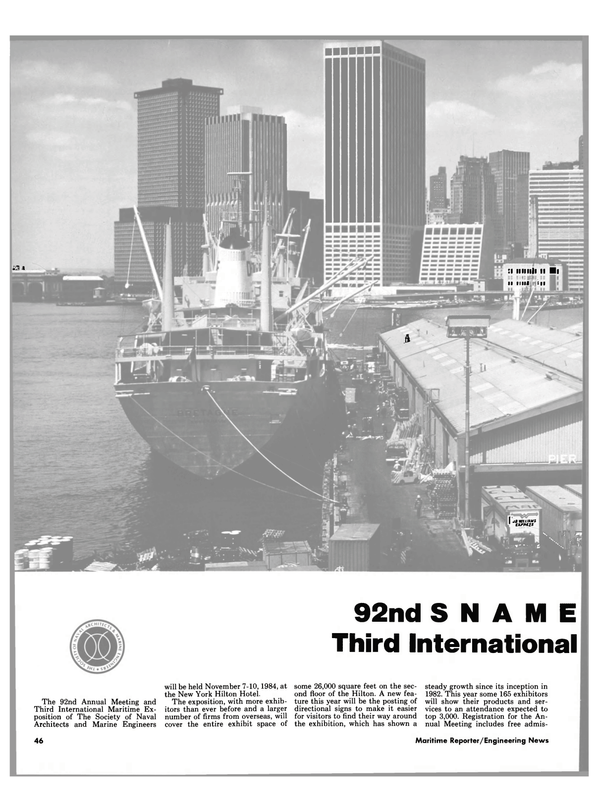
Valmet Delivers First Of Four Supply Vessels To Soviet Union
Valmet's subsidiary yard, Valmetin Laivateollisuus Oy in Turku, Finland, recently delivered the first unit in a four-vessel series being built for the Ministry of Gaz Industry of the USSR. The supply/ anchor-handling vessel Rioni incorporates a number of interesting features, like the "father and son" machinery installation, as well as onecompartment structural subdivision to provide extra safety for operations in harsh conditions such as the Arctic.
The Rioni (shown above) is the lead vessel in the series that will be delivered during 1984-85. Behind the customer's decision to place the order with the Valmet yard was, among others, the fact that Laivateollisuus already had good experience with such craft. In the mid-70s the Turku yard built a series of Ulstein type UT 704 vessels for I.M.
Skaugen in Norway and The Offshore Company of Houston. The Rioni type, however, is the yard's own design and is tailor made to meet the stringent requirements of the USSR rules and specifications.
The Rioni type is intended to serve the needs of offshore installations with the transport of pipe, bulk material, fresh and potable water, fuel, cement and mud, as well as food provisions in refrigerated containers. She will also be able to tow drilling rigs and other structures.
In addition, she will be able to carry and handle anchor chains and cables of the offshore structures, as well as take the drill sludge ashore in containers.
The Rioni has an overall length of 220.8 feet, beam of 45.6 feet, and design draft of 16.4 feet. Storage capacities are designed to give 30 days of uninterrupted operation with a complement of 24 and at an 85-percent machinery output.
The machinery arrangement comprises two separate propeller shafts, each driven via a reduction gear by two diesels of different sizes. Each diesel is coupled to the reduction gearbox by flexible couplings; in addition, the smaller engines are coupled from their front ends to separate alternators. Thus the smaller engines serve a dual purpose—as a main engine or as a generating set, either coupled independently.
All four diesels are of Wartsila type 22, the two larger in V form with 22 cylinders each and the two smaller units in R form with six cylinders each. The corresponding outputs are 2,420 bhp and 1,200 bhp, respectively, for a total vessel output of 5,330 bhp. Both of the smaller engines are fitted with 550- kva alternators. One generator is needed to serve the vessel in all conditions except when the 1,000-hp bow thruster and the towing winch or the cargo-handling equipment are in operation.
The two propellers are of controllable- pitch type fitted in fixed nozzles.
They can be controlled by joystick type operation from both ends of the bridge. Also on the bridge are remote controls for the towing winch, and alarm stopping of the cargo pumps.
The one-compartment structural subdivision is achieved by careful placement of the bulkheads and tanks. As a result, either of the compartments may be flooded without causing danger to the vessel.
Read Valmet Delivers First Of Four Supply Vessels To Soviet Union in Pdf, Flash or Html5 edition of November 1984 Maritime Reporter
Other stories from November 1984 issue
Content
- USS Iowa (BB-61) page: 4
- Saint John Shipbuilding Appoints Snyders VP And Manager, Shipbuilding Div. page: 5
- Greller and Belt Promoted At Ashland Petroleum page: 5
- Western Gear Relocates Corporate Headquarters To South Milwaukee page: 5
- Veson Computer Systems Offers Free Literature On Shipping Programs page: 6
- Webb Institute To Hold Annual Alumni Banquet page: 6
- Giannotti Awarded Contract For Ocean Thermal Study And Conceptual Design page: 6
- McLean Urges American Shipping Community To Remain Competitive page: 6
- Allen Named Director Of MDTSCO Washington Operations Divison page: 7
- Flint & Mercer Named Senior Vice Presidents For Eller & Company page: 7
- C. Plath And Racal Marine Controls Sign Cooperation Agreement page: 7
- Sandusky Offers Brochure On Centrifugal Castings page: 7
- MarAd Awards $4,250,848 In Contracts To Improve Productivity of U.S. Yards page: 8
- Braden Winch Marketing New Planetary Hoist page: 8
- Killian Named VP Of H.O. Penn Power Div. page: 8
- Watterworth Appointed Vice President-Operations For General Steamship page: 8
- Oil Content Monitor Offered By Salwico page: 9
- Drew, DHL In Agreement For Worldwide Port Fuel Evaluation Servic page: 10
- B&W And Flight Safety Form New Joint Venture Training Company page: 10
- Hoch Promoted At Comsat TeleSystems page: 10
- WABCO Forms Worldwide Parts And Service Network page: 10
- Rothermel Named Sales Vice President For Comsat TeleSystems page: 11
- Bay Shipbuilding Awarded $l 80-Million Contract To Build Three Containerships For Sea-Land page: 11
- Cable Splicing System Lowers Shipbuilding Costs page: 12
- Evans Appointed Vice President of ODECO page: 12
- U.S. NAVY SHIP OVERHAUL MARKET First Update — Changes As Of October 1984 page: 12
- Literature Available On Sperry's New Deepwater Navigation System page: 14
- Literature Available on New Ultra-Long-Stroke Diesel From M.A.N.-B&W page: 14
- 21 New Members Elected To ABS page: 15
- Mitsubishi Kakoki Offers New Products For Solving The Fuel Quality Problem page: 18
- Promotions Announced By Consolidated Grain page: 18
- Alden Introduces New Facsimile Transceiver page: 20
- Brown Named Director Of Marketing For Seaward International page: 20
- IMODCO Awarded Contract By Esso Suez For Mooring Terminal Offshore Egypt page: 22
- WABCO Introduces New Pneumatic Control Valve page: 22
- Moody-Tottrup Brochure Available On Offshore And Marine Industry Services page: 24
- CEC Awarded $2.5-Million Contract For Ship Unloader page: 24
- Mirrlees Blackstone Moves Into New Houston Facility page: 24
- Siwertell Develops New Design For Floating Bulk Transfer Station page: 26
- Richards & Associates Named Representative For Asea Marine's Line page: 26
- Nichols Brothers Boat Builders Christens Second Passenger Catamaran page: 28
- ABS Elects Gillies Vice President page: 28
- Racor Offers Literature On Its N e w Spin-On Fuel Filter/Water Separator page: 29
- Airco Introduces New Pulsed Welding Systems page: 29
- Bender Delivers Tour Boat 'Amarya' To Nigerian Government page: 30
- Sperry Introduces New 340-mm Radar, New Autopilot, And 'Marinized' PC page: 30
- Meyer Werft Launches One And Delivers Another Passenger Ship For Indonesian Inter-Island Service page: 32
- Twin Matson Container Barges Christened At McDermott Shipyard page: 32
- Renk Offers Reference List Of Marine Gear Units Used In Naval Vessels page: 32
- Aegis Cruiser "Valley Forge' Christened At Ingalls Shipyard page: 33
- Racor Offers Literature On Its Self-Regulating Diesel Fuel Line Heater page: 33
- Renk Offers Literature On RCF Generator Gears page: 33
- Alexander Industries Named Agent For Clow/Greenberg page: 33
- Kidde Offers Free Brochure On Total Fire Protection page: 33
- The Angel Of Competition page: 34
- Mctgnavox Introduces Civil Global Positioning System page: 36
- IMODCO Awarded Contract By Esso Suez For Mooring Terminal Offshore Egypt page: 36
- Eastern Marine Signs Contract For Passenger/Auto Ferry page: 37
- Blount Marine Yard Completes High-Speed Commuter Vessel page: 41
- Free Eight-Page Brochure Available From Racor page: 41
- Browning Named Contracts And Sales Vice President For Sonat Offshore Drilling page: 42
- Valmet Delivers First Of Four Supply Vessels To Soviet Union page: 42
- MarAd Submits Final Rule For Governing Evaluation Of Bids page: 43
- New Krupp Atlas ARPA Gets British DoT Type Approval page: 43
- Wartsila Turku Yard Delivers Big Catamaran Crane Vessel To USSR page: 44
- 92nd SNAME Annual Meeting Third International Maritime Exposition page: 46
- Dyvi Heavy Lift Vessel Busy Transporting Semisubmersibles page: 47
- RFD Survival Liferaft Line Gains Davit-Launch Approval page: 47
- Peck & Hale Offers Container Lashing System Literature page: 62
- AMMCO Enters License Agreement With Damen Shipyards Of Holland page: 64
- New Pipe Connecting System Reduces Costs page: 64
- Bender Christens And Launches Cruiser "Pilgrim Belle' page: 66
- New Literature Sheet Describes Simpson's Seaworthy Panel Products page: 68
- Continental Maritime Gets $18-Million Navy Contract For Crane Ship Conversion page: 68
- Three Offshore Service Fleets Plan Merger Into New Company page: 71
- Regency Introduces New Marine Transceiver page: 71
- Hydranautics Awarded Contract By Marathon Oil For Rig-Skidding Systems page: 71
- Western Gear To Build And Sell Rademakers Epicyclic Transmissions page: 72
- New Integrated Navigation & Command System From Krupp Atlas Elektronik page: 74
- Harbormaster Offers Free 8-Page Brochure On Propulsion Units page: 74
- Korea's Samsung Shipyard Offers 24-Page Brochure On Facilities, Capabilities page: 74
- Tl Has A New Fleet Management System To Improve Vessel Operating Efficiency page: 77
- N e w Bulletin M a k e s Small S t a n d a r d Heat Exchangers Easy To Select page: 78
- Paul King Appointed Division Manager For Sonat Offshore Limited page: 78
- Deutsch Metal Offers Free Pyplok Catalog page: 78
- New Brochure Describes John Crane Maintenance Training Center page: 80
- Gulf Oil Offers Free Full Color Guide To Marine Lubricants page: 80
- Farmer Named Worldwide Operations Manager For Sonat Offshore Drilling page: 82
- Ferrous Announces FMS, System For Administering Catalyst Into Fuel Oil page: 82
- New York Port Engineers Meeting Hears Paper on Computer Uses page: 83
- DIRECTORY U.S. NAVY BUYING OFFICES page: 84
- Cummins Introduces New Premium Grade Lube Oil For Diesel Engines page: 99
- Devoe Marine Announces Management Appointments page: 100
- ABS Publishes Its First Guide For Certification Of Thrusters page: 102
- SKF Steel Introduces New Simplified Coupling page: 103
- Holmatro Offers Brochure Showing Full Product Line page: 103
- Gladding-Hearn Delivers 76-Foot Offshore Lobster Boat page: 104
- Marine Engineers Shipyard Gets Contract To Build Schooner page: 107
- GM Engines Pass Offshore Tilt Test—Literature Available page: 112
- Flexaust Announces A Major Improvement In Its Product Line page: 113
- Design Manual Available On Teleflex Remote Mechanical Valve Actuator page: 113
- Lisnave Will Continue Technical Support To ASRY In Bahrain page: 119
- Du Pont Offers Free Brochure On New "Offshore Maintenance Painting Service' Program page: 119


